There are few manufacturers that have a long-storied history in the defense industry as Winchester. Undoubtedly, few things are more formidable or reliable in battle than a 12-gauge pump action shotgun. Winchester’s Model 1897 has proven over time to be a reliable firearm for protection of America’s finest.
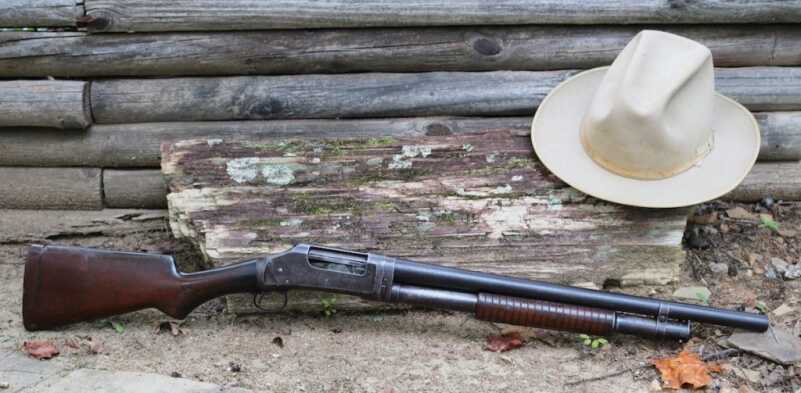
The Winchester 1897 shotgun is seminal Americana. Produced up until 1957, around a million copies entered circulation.
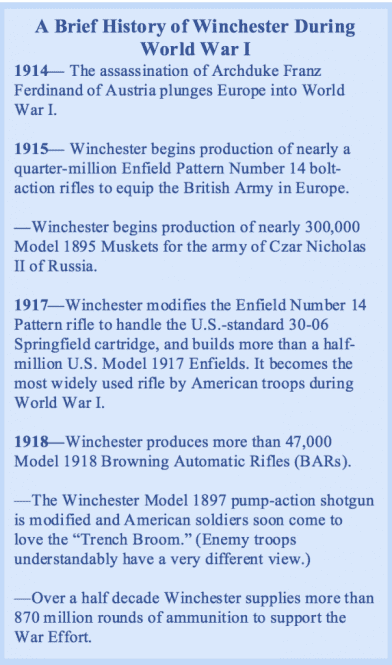 Eddie Mangione had grown up with literally nothing on a rural farm in Tennessee. Now he was a world away squatting in the fetid trenches of war-torn France. For Eddie the summer of 1918 had become surreal and otherworldly.
Eddie Mangione had grown up with literally nothing on a rural farm in Tennessee. Now he was a world away squatting in the fetid trenches of war-torn France. For Eddie the summer of 1918 had become surreal and otherworldly.
Eddie had joined the U.S. Marines for all the timeless reasons young men join the Marines. He wanted out of his drab familiar world, and military service overseas promised adventure, exotic locales, and camaraderie. Like so many others before and since Eddie found that reality differed from the lies the recruiters peddled. The adventure was horrifying, the exotic locale was dank, rotten, and miserable, and the camaraderie involved watching his friends get torn to pieces by artillery. He had only been in the trenches a month.
His fellow Marines clutched their 03 Springfield rifles. These instruments turned the Marine rifleman into a deadly agent of chaos. Their French Chauchaut light machineguns were utter rubbish, but these beautiful Springfields were perfected tools of the riflemen’s art. Eddie’s backwoods Southern upbringing had ultimately put a different weapon in his hands. Eddie’s stiff terrified fingers curled around the walnut stocks of a Winchester 1897 Trench Gun 12-gauge.
Eddie’s mission was to knock incoming German hand grenades aside before they could land in the trenches. Pushing nine OO buckshot pellets per round and carrying five rounds on board, Eddie’s shotgun had successfully accomplished this feat twice already. Eddie’s reputation as a backwoods wing shooter had been well founded.
The enemy artillery barrage finally lifted after what seemed an eternity. Several ears were bleeding from the overpressure, but the Hun artillery had not adequately ranged the thin linear targets that were the Allied trenches. Everyone in Eddie’s platoon still drew breath.
From 1897 to 1957 over 1 million of these shotguns were produced and notably during World War 1 and trench warfare. Eddie’s story is not unique. It’s a small glimpse into the reputation that makes a Winchester shotgun a legendary trench warfare tool.
Hunting Arm, Combat Tool, Gangster Gun
The influence of John Moses Browning on the world of firearms cannot be overstated. He designed several familiar lever-action Winchester rifles, some of the most influential handguns ever built, and all of the successful repeating shotguns available in the first part of the 20th century. At the time of his death, the man held 128 patents for various firearm-related inventions. His repertoire spanned the spectrum from .25-caliber pocket pistols to 37mm aircraft cannons. His 1897 shotgun ushered in a new era in scattergun technology.
The 1897 was itself an evolutionary development of the previous model 1893. The 1893 slide action gun bears an esoteric similarity to its later sibling but came up in the era of low-pressure blackpowder shotgun shells. The Model 1897 incorporated a stronger steel receiver that better surrounded the gun’s bolt. The resulting weapon was proofed for higher-pressure smokeless rounds. The 1897 was available in both fixed and takedown variants.

Despite being born in 1907, my high-mileage 1897 Winchester runs low brass birdshot as fast as you can cycle the action. I’d be slow to feed it large quantities of buckshot or slugs, however.

Once broken down the 1897 Winchester takes up very little space. This feature allowed for easy storage or concealment, depending on which side of the law you might find yourself.
As a sporting arm, the 1897 was fabulously successful. The gun cost $25 new when originally introduced and could be had with barrels reaching out to 36 inches. The external hammer served as a manual safety, and the American walnut stocks exuded a lithe almost effeminate vibe. However, the lack of a manual disconnector meant that the gunner could hold down the trigger and empty a five-round magazine as fast as he could cycle the forearm. Extending a tab on the far end of the magazine tube and rotating the assembly allowed the gun to break in half at the front of the receiver via interrupted threads. As a result, the 97 could be tucked into compact spaces for storage or concealment.
The militarized version of the weapon was universally referred to as the Trench Gun. This variant started as a 20-inch barreled 1897 to which was affixed a sheet steel heat shield-cum-bayonet lug and sling swivels. In this configuration, the Trench Gun saw action in both World Wars as well as a variety of brushfire conflicts in between. Though the guts of the gun resemble a sewing machine for their complexity, the 1897 Winchester rendered reliable service and was well-received by the troops who wielded it.
Resurrecting the Dead
If your gun collecting proclivities wander toward rarefied stuff like period Western guns or, Lord help you, transferable automatic weapons then you’d best be shaved and prepped to hock a kidney to pay for your habit. However, in the case of cool old shooters like the 1897 Winchester, getting into a facsimile of the guns used by J. Edgar Hoover’s G-Men to bring down Dillinger and Capone need not be spendy. A million of these old scatterguns rolled off the lines before production ceased in 1957. That means high mileage used versions are plentiful and cheap.
I found a shopworn 1897 that sported an absurdly long 34-inch barrel, little remaining finish, and an ugly home-built stock extension for a cool $250. While that was indeed a good deal, these old guns float around auction websites for a bit more than that all the time. Given the gun’s advanced age I could transfer it straight to my doorstep via my personal Curio and Relic FFL. Where others might see dingy, tired, and ugly, I sensed a diamond in the rough.
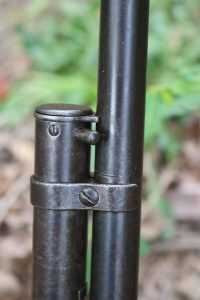
To break the gun down one simply presses this rod to the other side and uses it to unscrew the magazine tube about a quarter turn. John Browning had a gift for such as this.
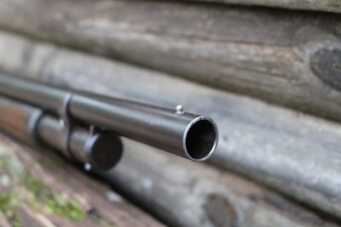
So long as care is exercised anyone with access to a table saw and drill press can do a professional job shortening a shotgun barrel. I touched up the cut end with my Dremel tool and fabricated a new front sight from a machine screw.
The gun was mechanically intact, and the takedown feature works as well today as it did when the gun first rolled off the Winchester line in 1907. The freckled brown patina lends the gun a pleasant been-there done-that ambiance. The inimitable American Walnut furniture ages better than Christie Brinkley.
Chopping the Tube
I have shortened a lot of shotgun barrels in my day and have found that all you really need to do it well is a table saw, a drill press, and a little patience. Run a cleaning rod down the barrel and mark the point where it meets the muzzle. This is the initial barrel length. If you want a fixed point like 18 inches for legality or, in this case, 20 inches for historical cred, just subtract that from your measured barrel length and make a mark with a Sharpie marker that far back from the muzzle. Wrap that spot in masking tape for a precise cut.
Mount up a fiber-reinforced cutoff wheel on your table saw and cut the barrel a time or two near the muzzle to get a feel for things. Tape an old towel over the top of your saw to protect the finish on the barrel. When you are comfortable with your technique, make your final cut in a single smooth motion. You can then dress the cut end with a Dremel tool and a sanding drum. If you are careful the pruned tube will look factory perfect.
Brass front sight beads are available online, but I’m cheap. I typically chuck a machine screw into my drill press and grind the head down into a ball with a file. Carefully spot the hole for your new front sight with a spring-loaded center punch, drill it meticulously with your drill press, and thread the hole with a hand tap. Seat the new sight with red thread locker. Then go back with the Dremel tool sanding drum to polish the stubby end of the new sight flat from inside the bore. If you want real performance from your new shortened barrel you can have the bore threaded internally for a choke tube.
Cogitations
The end result looks like something Elliot Ness might wield on his late-night raids against Al Capone’s Speakeasies yet set me back a whopping $250. Should you be in the market for a really inexpensive hunting arm, these old shotguns really never wear out. My resurrected 1897 runs birdshot like a champ as fast as you can cycle the action even at 110 years old.
The 1897 Winchester armed generations of American hunters, Law Enforcement Officers, criminals, and soldiers on their enterprises of sustenance, peacekeeping, crime, and combat. The gun’s takedown feature brings a capacity for
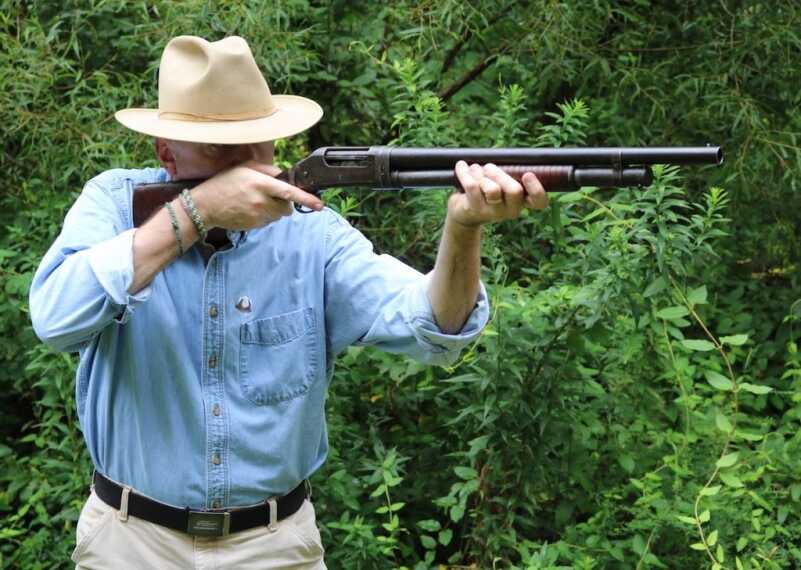
Originally only chambered in 12 gauge and 16 gauge, the Model 1897 cost $25 and barrel lengths ranged from 20 to 30 inches.
stowage or concealment not rivaled today. The restoration project also represents an inexpensive and fun way to kill an otherwise lazy Saturday afternoon.
For more information about Winchester shotguns, click here.
To purchase a Winchester Model 1987 on GunsAmerica, click here.

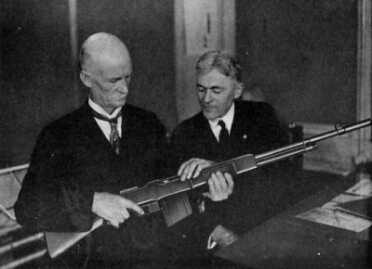

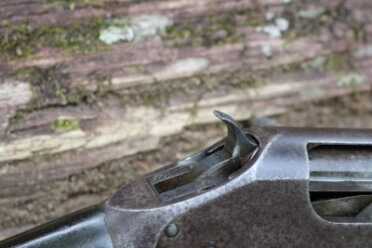
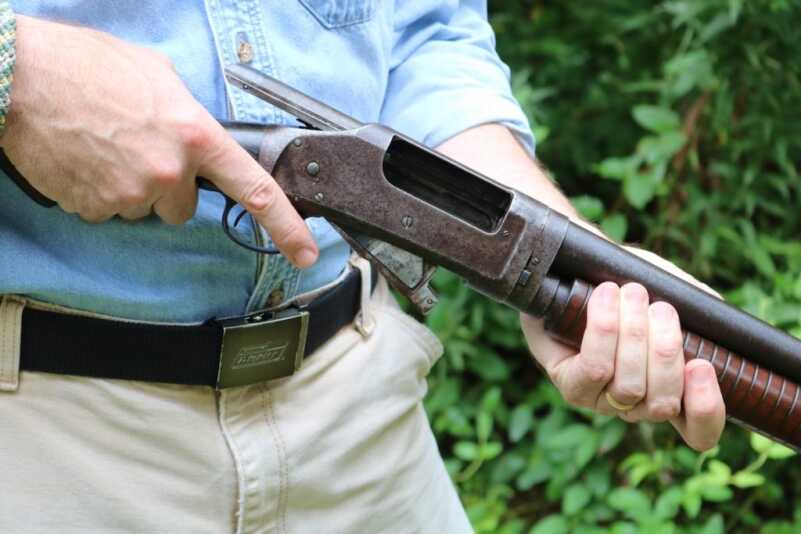

Great site, I have an 1897 ( Build Date is 1898 ) It has a 23in Barrel I can not find any info on what if any this length barrel would have been offered for. This a great review on the mod.1897 any help would be great.
Great old guns. Had one for home defense for years, finally upgraded to a Mossberg 500 Bull Pup.
That old shotgun shot a lot of pheasants and even a couple whitetail deer.
My dad used to use masking tape and a hacksaw or bandsaw to cut down shotgun barrels until I introduced him to Mr. Pipe Cutter. The cuts are always even, the outside muzzle had a nice crown, and the inside lip in the bore resulting from the pipe cutter can be easily deburred with a file, some sand paper wrapped around a dowel rod or a Dremel sanding drum.
I am a proud owner of one with the original bayonet it came with…never shot it…it proudly did service in the Pacific campaign during ww2… it’s now partnered with a 1940 navy colt 1911 and a 1942 m1 garand…all of which served in the war against japan…
I used a takedown version of the ’97 for Cowboy Action Shooting, and it always worked just fine. Norinco came out with a copy of the 97 some years ago, but guys who bought them said for the most part they were junk. They needed serious tweeking out of the box. Just a little comment, the article mentions the takedown feature, but not all 97’s had that. I know a guy who has one that does not break down.
This article reminds me of two friends that had experiences with the Mdl. ’97. The first was issued a 97 as his primary weapon in Korea. Fred was bitching up a storm, wanting a real gun(M1). He learned to love the point and shoot advantage in a special forces unit. The second experience was a life long neighbor on the next farm south of us. Les used the 97 every year for rabbits, pheasants, and deer. It was a ritual to shoot at a paper plate tied to a bale of straw. On this year particular year the locking lug at the front of the bolt broke off, and allowed the rest of the bolt to carve a nasty gouge along his right cheek, and just below his right eye. Les missed deer season. Consider having the bolt magna-fluxed or a similar process to check for cracks, that are too small to see, and check the possibility of having the bolt stress relieved to prevent a possible death.
Regards,
Bob
I have two 12 ga 1897’s 28 Mod as new with less than three boxes of shell run through it from the early 50’s and a 32 inch full choke from the 20’s which still has around 80% original finish left on it and i love hunting with these old guns. I use the 32 inch full for squirrel hunting and it will reach up in the tallest hickory’s and bring them down. I grew up in the late 50’s and 60 using the 97 for hunting small game and the 97 is still my all around favorite pump gun.
I’m looking for a trench gun barrel with bayonet lug and heat shield guard to convert my shotgun
Title screw up: 1897 not 1987. Lol
Might to change that 1987 in the title… 🙂